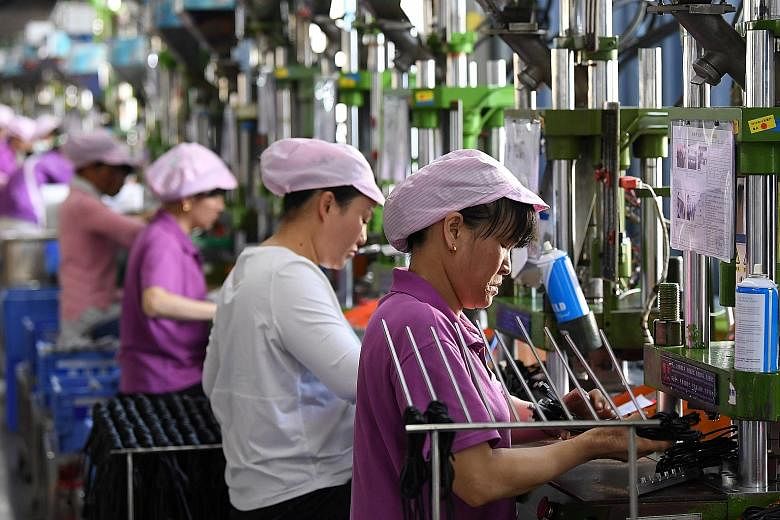BEIJING • China's economy stabilised in the first three months of the year, according to official figures released yesterday, after Beijing flooded the financial system with money in a whatever-it-takes approach to arrest a slowdown.
Officials said the Chinese economy, the world's second-largest, grew 6.4 per cent in the year's first quarter compared with the same period in 2018. The pace matched that of the fourth quarter, when growth suffered as shoppers pared back, the stock market slumped and private businesses pleaded for help.
While economists generally regard China's economic figures with scepticism, they point to other signs that the country's slowdown may have reached bottom. Figures suggest shoppers are back at the tills, factory output is ticking up and the world, after several tough months, is buying more Chinese goods. Beijing needs such hopeful signs as it tries to reach a trade deal with the Trump administration while under pressure to lift conditions at home.
Economic growth so far this year "laid a sound foundation for the stable and healthy economic development of the whole year", said Mr Mao Shengyong, a spokesman for the National Bureau of Statistics.
There is a caveat: The signs of improvement most likely do not stem from a burst of confidence in the strength of the country's economy among Chinese business leaders.
Instead, the positive glimmers are largely a product of the hundreds of billions of dollars Beijing pumped into the economy in recent months and the loans that officials have pressed state-run banks to make. All of that comes at a cost, and raises a question about how willing Beijing is to spend to keep growth going.
"This time they used an overwhelming amount of force to boost the economy," said Mr Larry Hu, chief China economist at Macquarie Group. "That is why the economy stabilised in the first quarter."
The chance of a "double dip", in which growth drops again before picking up later this year, is high, Mr Hu added. "The recovery is not that solid," he said. "They front-loaded the policy firepower at the start of the year."
In many ways, China's policymakers are reverting to an earlier approach: doling out more loans in exchange for a short-term increase in confidence. The strategy helped keep growth surging over the past decade, even after the 2008 global financial crisis. But it left the country awash in debt that threatens to hamper the economy in the years ahead.
In the early years of China's boom, companies and local governments could borrow liberally knowing that accelerating growth could help ensure that their gambles paid off. Now that the economy is huge and maturing, it has become increasingly difficult for China to simply grow its way out of its debt.
"China already is in the midst of the largest credit bubble the world has ever seen," said Associate Professor Victor Shih of the University of California, San Diego. And, he added, the Chinese government has not been able to wean itself off its debt habit.
"The government simply cannot afford to think about the medium term and must focus on short-term continuation of the credit bubble," he said.
The latest round of government-driven financial largesse was remarkable in size and scale, economists said. The broadest measure of new borrowing in China, known as total social financing, jumped to US$1.2 trillion (S$1.6 trillion) in the first quarter, while bank lending hit a record high of US$865 billion, according to Macquarie's Mr Hu.
Local governments, encouraged by the central government, raised US$100 billion in new money through special bonds compared with US$11.5 billion in the first quarter of last year.
This money started to show up in the economic data on Wednesday, with spending for massive infrastructure projects like toll roads and subway lines gaining 6.3 per cent.
On Tuesday, the Organisation for Economic Cooperation and Development warned of the hazards of such heavy borrowing, saying it could yield bigger economic imbalances in the future.
The organisation revised its outlook for China's growth to 6.2 per cent for this year and 6 per cent for 2020, citing the heightened risks of a housing collapse and growing geopolitical tensions.
NYTIMES

